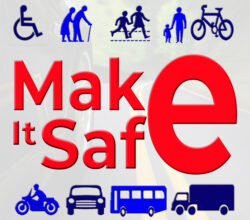Arrive alive and not dead on time When driving, a few miles per hour can mean the difference between life and death. The faster you drive, the less time you have to stop if something unexpected happens. If you kill someone whilst speeding, you will have to live with the long-term emotional consequences. Speed limits are there for a reason Make the glove compartment the phone compartment It doesn't matter how far the journey is… just belt up! Seat belts and child seats are an important part of keeping you and your loved ones safe if the worst happens on the roads. It doesn't matter how far the journey is... just belt up! The safest way for children to travel in cars is in a child seat that is suitable for their weight and size. Even in a minor crash, an unrestrained child would be thrown about inside the vehicle, injuring themselves and others. They could be thrown from the car through one of the windows. For more information on fitting child car seats, visit: www.rospa.com/road-safety/resources/films/child-car-seats/ The Highway Code says that drivers must ‘make sure dogs and other animals are suitably restrained’ in your car. If you don’t follow the Highway Code, you could be considered to be driving without due care and attention. If you’re in an accident because you were distracted by your pet, this could be counted as dangerous driving. Benefits of keeping pets secured include: Have none for the road! If you are driving, its better to have NONE for the road If you drive whist using drugs, you are out of your mind There are strict penalties if you are convicted of drink/drug driving, including: However, this list does not reflect the everyday consequences of being caught drink/drug driving which can include: Most drink drivers don't plan to break the law. Make sure you don't become another statistic; here are some ways to avoid drinking and driving: Inappropriate Speed
 Drivers and riders who are travelling at inappropriate speeds are more likely to crash
Drivers and riders who are travelling at inappropriate speeds are more likely to crashThe facts
The law

Using a Mobile Phone whilst Driving
 Using a hand-held or hands-free mobile phone whilst driving is a significant distraction.
Using a hand-held or hands-free mobile phone whilst driving is a significant distraction.The facts
The law
Not Wearing a Seatbelt
 Seatbelts are designed to retain people in their seats, and so prevent or reduce injuries suffered in a crash.
Seatbelts are designed to retain people in their seats, and so prevent or reduce injuries suffered in a crash.The facts
The law
Child car seats
Dogs
Drink/Drug Driving
 Often it is an innocent person who suffers, not the driver who is drink/drug driving
Often it is an innocent person who suffers, not the driver who is drink/drug drivingIt is an offence to drive whilst unfit through alcohol or drugs
The Facts
The consequences
There's always an alternative



MakeItSafe Aiming to reduce the number of people killed and seriously injured on the road.
The “Fatal Four” refers to the four leading causes of fatal accidents on the road. These factors contribute significantly to the number of serious injuries and fatalities in traffic incidents. By understanding and addressing these factors, we can work towards creating safer road environments. The Fatal Four include:
1. Speeding: Speeding is a major contributor to road accidents and fatalities. Driving at excessive speeds reduces the time available for drivers to react to unexpected situations, increases stopping distance, and makes it harder to control the vehicle. It also amplifies the force of impact in a collision, leading to more severe injuries. Adhering to speed limits and adjusting driving speed based on road conditions is essential for reducing the risk of accidents.
2. Drunk Driving: Driving under the influence of alcohol or drugs impairs judgment, slows reaction time, and affects coordination and concentration. This greatly increases the likelihood of accidents and injuries. It is crucial to never drive while intoxicated and to always designate a sober driver or use alternative transportation options if you have consumed alcohol or drugs.
3. Distracted Driving: Distracted driving is a growing concern with the rise of smartphones and other electronic devices. Activities such as texting, talking on the phone, using GPS systems, eating, or grooming divert the driver’s attention from the road and increase the risk of accidents. It is essential to eliminate distractions and focus solely on driving to ensure a safe journey.
4. Not Wearing Seatbelts: Failure to wear seatbelts significantly increases the risk of severe injury or death in the event of an accident. Seatbelts are designed to restrain occupants during sudden stops or collisions, preventing them from being ejected from the vehicle or hitting hard surfaces inside. It is crucial for all occupants to wear seatbelts properly and consistently, regardless of the distance traveled.
Addressing the Fatal Four requires a combination of education, enforcement, and public awareness campaigns. It is essential for drivers and passengers to understand the dangers associated with these factors and to take responsibility for their own safety and the safety of others on the road.
By promoting safe driving behaviors, strict enforcement of traffic laws, and public education campaigns, we can make significant progress in reducing the number of accidents and fatalities caused by the Fatal Four. Remember, each individual has a role to play in creating safer roads and preventing unnecessary tragedies.
![]()
